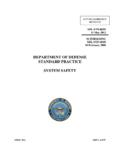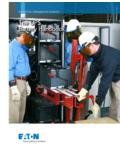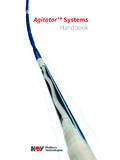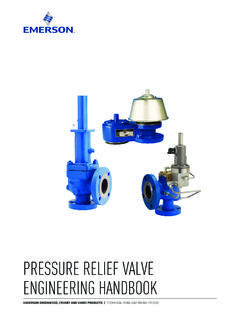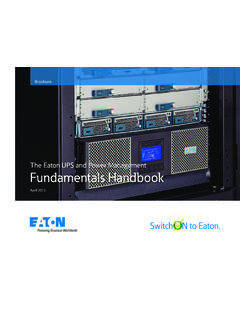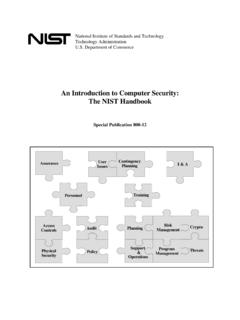Transcription of Introduction What equipment is covered by the …
1 Health and safety Executive Lifting equipment at work A brief guide Introduction This leaflet provides general information about the requirements of the Lifting Operations and Lifting equipment Regulations 1998 (LOLER). It describes what you, as an employer, may need to do to protect your employees in the workplace. It will also be useful to employees and their representatives. However, it is important that you also refer to the Regulations and Approved Code of Practice to familiarise yourself fully with your duties. What equipment is covered by the Regulations? Lifting equipment includes any equipment used at work for lifting or lowering loads, This is a web-friendly including attachments used for anchoring, fixing or supporting it. The Regulations version of leaflet cover a wide range of equipment including, cranes, forklift trucks, lifts, hoists, INDG290(rev1), mobile elevating work platforms, and vehicle inspection platform hoists.
2 The published 03/13 definition also includes lifting accessories such as chains, slings, eyebolts etc. LOLER does not apply to escalators, which are covered more specifically by the Workplace (Health, safety and Welfare) Regulations 1992. If you allow employees to provide their own lifting equipment , then this too is covered by and should comply with the Regulations. Do the Regulations apply to me? If you are an employer or self-employed person providing lifting equipment for use at work, or you have control of the use of lifting equipment , then the Regulations will apply to you. They do not apply if you provide equipment to be used primarily by members of the public, for example lifts in a shopping centre. However, such circumstances are covered by the Health and safety at Work etc Act 1974 (HSW Act). While your employees do not have specific duties under LOLER, they do have general duties under the HSW Act and the Management of Health and safety at Work Regulations 1999 (the Management Regulations), for example to take reasonable care of themselves and others who may be affected by their actions and to co-operate with others.
3 The Regulations cover workplaces where the HSW Act applies this includes factories, offshore installations, agricultural premises, offices, shops, hospitals, hotels, places of entertainment etc. Page 1 of 8. Health and safety Executive What do the Regulations require me to do? You need to make sure that when using any lifting equipment the requirements of LOLER are met. For example, you should make sure that all lifting equipment is: sufficiently strong, stable and suitable for the proposed use. Similarly, the load and anything attached (eg timber pallets, lifting points) must be suitable;. positioned or installed to prevent the risk of injury, eg from the equipment or the load falling or striking people;. visibly marked with any appropriate information to be taken into account for its safe use, eg safe working loads. Accessories, eg slings, clamps etc, should be similarly marked. Additionally, you must make sure that: lifting operations are planned, supervised and carried out in a safe manner by people who are competent.
4 Where equipment is used for lifting people it is marked accordingly, and it should be safe for such a purpose, eg all necessary precautions have been taken to eliminate or reduce any risk;. where appropriate, before lifting equipment (including accessories) is used for the first time, it is thoroughly examined. Lifting equipment may need to be thoroughly examined in use at periods specified in the Regulations (ie at least six-monthly for accessories and equipment used for lifting people and, at a minimum, annually for all other equipment ) or at intervals laid down in an examination scheme drawn up by a competent person. All examination work should be performed by a competent person (someone with the necessary skills, knowledge and experience);. following a thorough examination or inspection of any lifting equipment , a report is submitted by the competent person to the employer to take the appropriate action.
5 Why is lifting equipment safety important? Working with any machinery can be dangerous because moving machinery can cause injuries in many ways: People can be hit and injured by moving parts of machinery or dropped or ejected material. Parts of the body can also be drawn in or trapped between rollers, belts, chains and pulley drives. Sharp edges can cause cuts and severing injuries, sharp-pointed parts can stab or puncture the skin, and rough surface parts can cause friction or abrasion. People can be crushed both between parts moving together or towards a fixed part of the machine, wall or other object, and two parts moving past one another can cause shearing. Parts of the machine, materials and emissions (such as steam or water) can be hot or cold enough to cause burns or scalds and electricity can cause electrical shock and burns. equipment or attachments can become unreliable and develop faults due to poor or no maintenance, or machines may be used improperly through inexperience or lack of training.
6 Parts of the equipment may fail and loads may drop. Lifting equipment at work: A brief guide Page 2 of 8. Health and safety Executive Before you start Before you start using any equipment you need to think about what risks may occur and how these can be managed. You should: Check that it is complete, with all safeguards fitted, and free from defects. Produce a safe system of work for using and maintaining the equipment . Maintenance may require the inspection of critical features where deterioration would cause a risk. Also look at the residual risks identified by the manufacturer in their information/instructions provided with the equipment and make sure they are included in the safe system of work. Make sure the equipment has been installed properly, is stable and is not in a location where other workers, customers or visitors may be exposed to risk. Make sure you have chosen the right equipment for the job.
7 Note that new equipment should be CE marked and be supplied with a Declaration of Conformity and instructions in English. Make sure the equipment is: safe for any work that has to be done when setting up, during normal use, when carrying out repairs for breakdowns or faults, and during planned maintenance;. properly switched off, isolated or locked-off before taking any action to remove blockages, clean or adjust the equipment . Also, make sure you identify and deal with the risks from: electrical, hydraulic or pneumatic power supplies;. badly designed safeguards. These may be inconvenient to use or easily overridden, which could encourage your workers to risk injury and break the law. If they are, find out why they are doing it and take appropriate action to deal with the reasons/causes. Preventing access to dangerous parts Think about how you can make the equipment safe; the measures you use to prevent access to dangerous parts should be in the following order.
8 In some cases it may be necessary to use a combination of these measures: Use fixed guards (eg secured with screws or nuts and bolts) to enclose the dangerous parts, whenever practicable. Use the best material for these guards plastic may be easy to see through but may easily be damaged. Where you use wire mesh or similar materials, make sure the holes are not large enough to allow access to moving parts. If fixed guards are not practicable, use other methods, eg interlock the guard so that the equipment cannot be started before the guard is closed and cannot be opened while the machine is still moving. In some cases, trip systems (such as photoelectric devices, pressure-sensitive mats or automatic guards) may be used if other guards are not practicable. Where guards cannot give full protection, use jigs, holders, push sticks etc if it is practicable to do so. Control any remaining risk by providing the operator with the necessary information, instruction, training, supervision and appropriate safety equipment .
9 Lifting equipment at work: A brief guide Page 3 of 8. Health and safety Executive Other things you should consider Make sure control switches are clearly marked to show what they do. Have emergency stop controls where necessary, eg mushroom-head push buttons within easy reach. Make sure operating controls are designed and placed to avoid accidental operation and injury. Use two-hand controls where necessary and shroud start buttons and pedals. Do not let unauthorised, unqualified or untrained people use lifting equipment . never allow children to operate or help with lifting equipment . Some workers, eg new starters, young people or those with disabilities, may be particularly at risk and need instruction, training and supervision. Adequate training should ensure that those who use the equipment are competent to use it safely (they have the necessary skills, knowledge and experience), and are physically suited to the task.
10 Make sure the work area around the equipment is kept clean and tidy, free from obstructions or slips and trips hazards, and well lit. Dos and don'ts of equipment safety As the dutyholder you should make sure that all employees likely to use lifting equipment , understand and follow these dos and don'ts: Do . check the equipment is well maintained and fit to be used, ie appropriate for the job, working properly and all the safety measures are in place;. make sure all parts, including attachments, can accommodate the load weight;. use the equipment properly and in accordance with the manufacturer's instructions;. make sure employees are wearing the appropriate protective clothing and equipment , required for that machine, such as safety glasses, head protection and safety shoes. Don't . use equipment that has a danger sign or tag attached to it. Danger signs should only be removed by an authorised person who is satisfied that the equipment or process is now safe.











